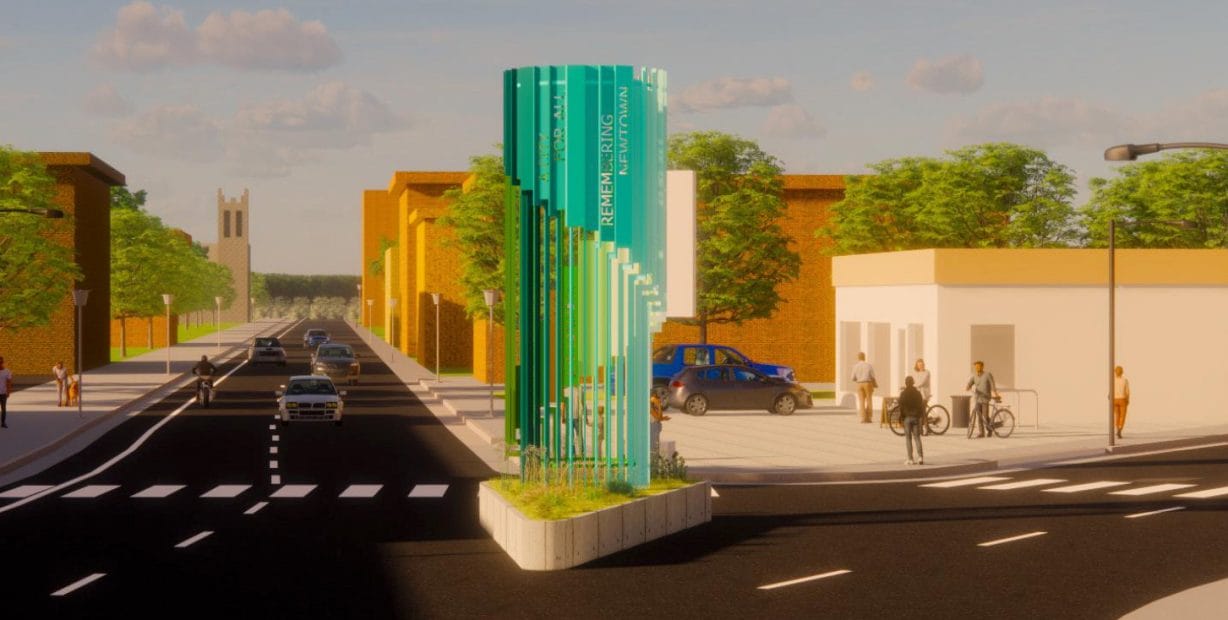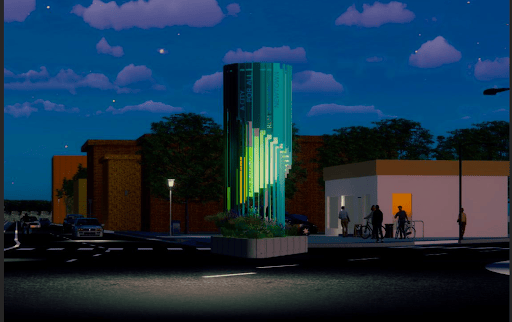
By Rachel Petterson, contributor
By the end of the winter, a new art installation will welcome people to downtown at the point where North Main Street and North Liberty Street split. And while city council members embraced the proposed piece’s concept and design Tuesday night, they had some concerns about its placement.
This will be the result of the North End Public Art Installation project, a process that started more than a year ago.
The art installation is called the Beacon and is designed by Nicholas Brinen, the principal partner of Studio Figure, LLC, in Charlottesville and a faculty member in JMU’s architecture department.
Kristin McCombe, the city’s community development block grant coordinator, presented the installation’s concept at Tuesday’s meeting. She explained various levels of symbolism, which involves the use of shape and the interaction between shadows and light to represent the past and hope for the future of Harrisonburg.
The city gathered feedback from the public while deciding how to design this public art, and one of the pieces of feedback they received, said Michael Parks, the city’s communications director, was that the installation should have an element of “remembering Newtown,” which was a portion of the northern end of downtown Harrisonburg where the installation will be. Newtown was populated by freed African Americans settled there after the Civil War, and in the mid-20th century, Harrisonburg officials displaced the families living there in the name of “urban renewal.”
That saga is embedded in the artwork.
“The shadows cast by the ribbon suggest the memory of voices of those who were forced to leave their homes and the voids represent spaces that were left behind,” McCombe said. “The Beacon acknowledges the harm that was done to the community and serves as a reminder of the need for healing and hope. The Beacon also celebrates the rising diversity of Harrisonburg– the ribbons of this structure shift and lengthen positions to reflect this diversity.”
Other symbolism went into the design. For example, the silo shape also represents the agricultural history of the city.

The council unanimously gave support to the project and its design in a 4-0 vote, with council member Monica Robinson absent. However, all present members of the council expressed concern over the location of the installation in the middle of the road where pedestrians cannot safely and readily go up to the sculpture and touch it. It is currently set to be in the middle of the road and there is currently no crosswalk there.
Mayor Deanna Reed and Vice Mayor Laura Dent both said that they anticipate that people will come up to the installation regardless of whether there is a built-in means of doing so.
Council member Chris Jones pointed out that if people were to go through the street to be close to it and an incident came of it, the public may wonder why the city did not visibly do something to prevent it.
Jones said he wants people to be able to touch the installation.
“I wanted it to be more tangible,” he said. “I don’t want to see a new version of people not being able to get close.”
He also pointed out that a good portion of the installation would not be visible except from the middle of the street, north of the installation.
Council member Dany Fleming suggested putting up signs on the sidewalks explaining the Beacon so that people could view it and read about it, and that this area could include pieces of the material the installation would be made out of.
McCombe told The Citizen that she anticipates the Beacon going up by the end of this coming winter. Because the council approved the concept, she does not anticipate anything that would halt the project’s progression.
The Arts Council of the Valley and Harrisonburg Downtown Renaissance have partnered with the city on the public art project.
Updates to come on skate park replacement
The city parks and recreation director will provide an update to the community about what comes next now that the skate park was razed this spring. Those meetings could start potentially as soon as the end of this month.
The city had long planned to upgrade the skatepark and were set to use funds from the federal American Recovery Plan Act, or ARPA, but members of the skate community, such as Paul Somers, opposed the plan to rebuild using steel and with hiring the American Ramp Company to construct it.
Brian Mancini, the director of parks and recreation, will hold a meeting with individuals who have been vocal about this issue to update them at some point after the next council meeting on July 25, Reed said.
That is an important next step, said Parks, the city communications director.
“We want to make sure that we can have conversations with them, understand what it is they need, try to make clear some of the things that are the parameters that we have to work within, just so we can have positive conversations because we know that there’s frustration in the community,” Parks said.
He said these meetings would be set up through direct communication between the community members and the city and are not public meetings.
He wrote to The Citizen after Tuesday’s meeting that this meeting will be small, and “the conversation will likely focus more on how we can work together and less on the specifics of the project so we can all understand where each party is coming from.”
City moving forward with planned homeless shelter
The timeline for the planned homeless shelter in Harrisonburg has been delayed to Fall 2024, instead of this coming fall as it was previously projected.
At Tuesday’s meeting, the council confirmed that they are moving forward with the plan of opening it at 1111 N. Main St. by unanimously voting 4-0 to confirm that the project fits with the rest of the city’s Comprehensive Plan — a kind of overarching guiding document for the city.
The council — according to state law — must take a specific vote on public construction projects that aren’t already included in the Comprehensive Plan.
Reed said because the planned shelter will be next to the Harrisonburg-Rockingham Community Service Board building, it makes the location particularly ideal.
Jones said he believes the shelter in that location is an economically sound decision and does not believe it will drive down the value of the surrounding properties, considering that he has continued to see businesses interested in the area even since the homeless shelter was projected to be there.
Council discusses Simms Center improvements
Luke Morgan, the city’s grant and programs analyst, said Tuesday that the city applied for $155,000 in funding through the National Park Services’ History of Equal Rights Grant Program. If successful, the city can use the funds to remove rust and repair materials around the windows of the Lucy F. Simms Center and install storm windows.
The current windows will not be removed; the storm windows are in addition to them.
Morgan said the city should learn about the funding in November.
Dent said installing storm windows would be a good step as the city looks toward becoming more energy efficient.
Ande Banks, the city manager, said this kind of historic preservation could be incorporated into next year’s budget regardless of whether the city is successful at receiving this grant.
Upcoming events and other news
- From 4-8 p.m. today, July 12, residents of Harrisonburg can order a CiCi’s pizza for free and it will be delivered by a firefighter who will also check residents’ smoke alarms and carbon monoxide detectors as part of the annual Smoke Alarm and Free Pizza Night.
- The Virginia Department of Agriculture and Consumer Services and the USDA will be assessing the region and city to see whether there is a need to apply pesticide against the spotted lantern fly.
Thanks for reading The Citizen, which won the Virginia Press Association’s 2022 News Sweepstakes award as the top online news site in Virginia. We’re independent. We’re local. We pay our contributors, and the money you give goes directly to the reporting. No overhead. No printing costs. Just facts, stories and context. We value your support.
